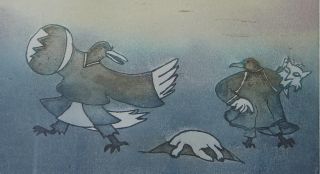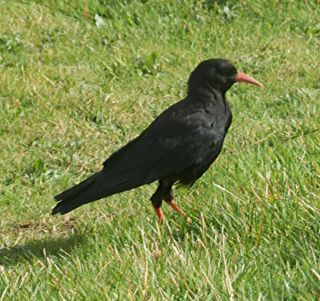Red-billed Chough
Crowing about Ireland
By Mark Brazil | Oct 26, 2015
Most of us know the land of hurling, folk music, Gaelic football and Guinness as Eire or Ireland. As I travelled through that country’s southern counties last month, I couldn’t help thinking of it as Corvidland. It seemed that everywhere I went I encountered members of this widespread tribe of birds.
In historical times, and until relatively recently, crows had a terrible rap. They were associated with darkness, doom and death. Ravens were believed to foretell death and all of the others were similarly tainted if they bore black plumage - and many, but not all, do. Today, the crows are better known for their generally high intelligence when compared with other birds and for the fact that some of them reveal abilities to solve complex and sequential problems. Here in Japan, crows have learned to fly up and drop shellfish from above to break them open on rocks or concrete below; other individuals routinely enlist vehicles using innocent passing vehicles to crush open walnuts that the crows have placed in their path on the road, and ravens, Japan's largest corvid have been observed participating in complex play behaviour during winter in Hokkaido. Elsewhere in the world crows have been found capable of resolving complex multi-step problems to gain access to food during experiments. (See these amazing videos https://www.youtube.com/watch?v=AVaITA7eBZE and https://www.youtube.com/watch?v=EtbCWbFU1xg).
In Ireland, other than shellfish dropping, I didn’t witness any direct examples of extreme intelligence amongst the crows, but I did witness their diversity, flexibility in habitat occupation and Catholic tastes. It seems that crows in Ireland are as at home in busy urban centres as they are in suburban streets with their well planted gardens, and also do well in the great extent of the rural agricultural lands, and even on the moorlands, hills, mountains and along cliff tops.
In the wooded estate of the national park at Killarney I found the Eurasian Jay to be secretive and shade loving. In urban and rural areas I found boldly pied Eurasian Magpies everywhere; they were both conspicuous and fearless. Alongside the magpies I found diminutive, grey-cowled Western Jackdaws and larger, barefaced Rooks. The jackdaws seemed especially at home around historical sites and buildings, finding sanctuary in the cavities and crevices in the walls, spires and towers of old churches and castles; they also seemed to like ancient trees. The Rooks meanwhile were in flocks that seemed to be present in almost every field, pushing their sharp-pointed beaks down into the surface soil or turf in search of invertebrates, and I saw them regularly on roadside wires and foraging along the verges of busy roads. Less common were the Hooded Crows. These black crows seemingly wearing grey vests are relatively scarce in Ireland occurring alone or in pairs in wilder parts of the countryside with hill sheep farms and woodland.
There are interesting parallels between the crow fauna of Ireland and of Japan - on these widely separated essentially temperate islands at the opposite ends of the vast Eurasian continent. Here in Japan we also have jays in our woodlands; but we have the all black Carrion Crow instead of their close relative the Hooded Crow. In winter we too have Rooks, albeit only down the western coasts and in Kyushu, while magpies are resident but strangely localized only in northern Kyushu and southwest Hokkaido. The Northern Raven remains, somewhat mysteriously, as only a scarce winter visitor in northernmost Japan (Hokkaido), whereas it is resident in Ireland. It is odd that it does not breed in Hokkaido given that there is so much suitable habitat for it and plentiful food year round thanks to a combination of agricultural and fisheries activities year round.
Whereas Ireland has the common and widespread Western Jackdaw, the closely related black and white Daurian Jackdaw is a scarce winter visitor to Japan occurring mostly in southwestern Kyushu where it mingles in with the rook flocks. Japan has its infamously marauding Large-billed Crows around every village, town and city, a species that Ireland lacks completely, though there jackdaws and magpies seem to occupy their niche and are similarly common or even abundant. Large-billed Crows create fear amongst some urban residents thanks to their habit of defending their nesting territories by swooping in low over the heads of anyone walking or cycling by. Though fearsome, these large crows are, along with the numerous Black-eared Kites an important part of the natural recycling process and garbage disposal!
Entirely lacking from Japan, though present in Ireland, is a unique and unusual member of the crow tribe – the Red-billed Chough. It is a bird equally at home on the steppes of Central Asia and it may be found also in some mountainous areas of Europe, but I found Ireland's most unusual corvid at the spectacular cliffs of Moher against a backdrop of wonderfully dramatic and breath-taking coastal scenery. This unusual crow not only has a deep red bill but it also has conspicuously bright red legs. The chough's bill is unusual among crows in that it is not only very sharply pointed but it is also distinctly down-curved, both aspects are adaptations to its unique foraging habitat. This is a bird of coastal areas (and mountains and steppes) where its preferred habitat of short, dense turf can be found. In Ireland it can be found especially along cliff tops where salt spray and strong winds limit plant growth to the very types among which the chough likes to forage. There it probes deeply into turf and soil for its invertebrate prey. Between times it is aerobatic and vocal, flying in small flocks riding strong updrafts off the fierce faces of the cliffs on broad-tipped black wings like a fearless base jumper with a wing suit. The bird’s call, often repeated, is a distinctive, resounding “chow” that gives this bird its name.
Crows feature surprisingly frequently in idiomatic English. Perhaps this is because crows are common enough birds for all speakers to be familiar with them and to understand their habits, thus making it easy for everyone to immediately grasp the implications of any reference to them. “As hoarse as a crow” is a clear way of describing someone’s rough rasping voice; “to crow about (or over) something” means to brag usually overly loudly about something; “to eat crow” means to admit one’s mistake; “crow bait” refers to someone or something that is useless or likely to die soon; “as the crow flies” refers to the straight line distance over the ground; “crow’s feet” refers to the wrinkles at the outer corners of the eyes; “shoot the crow” is rhyming slang for “go”; and “stone the crows!” is a somewhat dated expression of extreme surprise.
Outro
Author and naturalist Dr Mark Brazil has written his Wild Watch column continuously since April 1982. All Wild Watch articles dating back to 1999 are archived here for your reading pleasure. A collection of Mark’s essays The Nature of Japan has been published and is also available from www.japannatureguides.com











